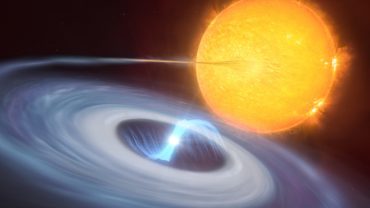
This artist’s impression shows a two-star system where micronovae may occur. Credit: ESO/M. Kornmesser, L. Calçada
It’s not often that a new astronomical phenomenon is named, but this month we have a new one. The name might not be that original, but there have been the first observations of something known as a “micronova”. Lasting just a few hours, a micronova is much fainter than a typical “nova”, making them much harder to detect, and much less likely to be picked up. Chris North and Edward Gomez discuss what causes these events.
Coming closer to home, spaceflight has been busy, with two missions to the Space Station in April – one part of the normal rotation of astronauts, and the other a privately-funded mission from SpaceX. Does this mean that space travel is becoming routine? And is that even a good thing?
Most of our exploration of space is, of course, done by robotic spacecraft, and NASA have just announced extensions to a number of their ongoing missions. Some of which have already been going for over 20 years – take a bow, Mars Odyssey! From rovers on Mars to lunar mappers, and from asteroid encounters to voyagers into the unknown, there’s still more exciting science to come from these missions.





